Registan
SAMARKAND REGISTAN
Registan square is the heart of old Samarkand, and it has been carefully restored to its original glory. It ranks first in Central Asia and is among the greatest of all the grandiose and magnificent works of the Islamic world. Registan translates as a ‘Sandy Place’ and the legends say that the soil here was covered with the sand in order to absorb the blood of the victims of public executions, that were allegedly performed on this spot until the 20th century.
Another legend tells that Registan was the place where Tamerlane used to present the heads of his victims, which were impaled on pins, as well as the place where the people gathered to listen the royal decrees, that were announced together with the fanfares from the loudly trumpeted copper pipes (probalby similar to what you sometimes see nowadays with the pilgrims arriving back to Uzbekistan).
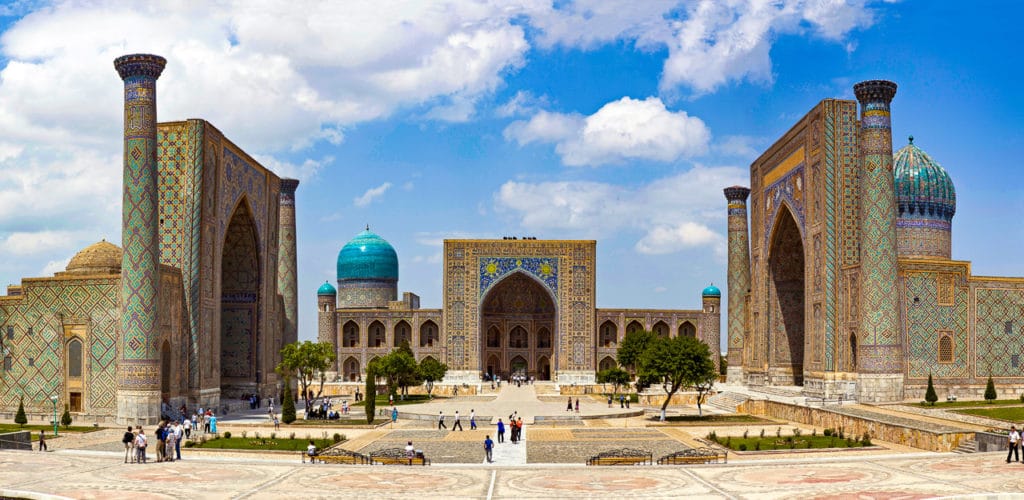
In addition to the activities mentioned, Registan’s main purpose was being the commercial center of the medieval Samarkand that was a major stop on the silk road. The unique feature of this square are the three giant madrasahs dating back to the 15th – 17th centuries, that each are beautiful monuments of the oriental architecture. For this reason, Registan is included in the UNESCO World Heritage List.
Registan originally grew up around the tomb of the 9th-century saint Imam Muhammad ibn Djafar, but by the 14th century, this was also the commercial heart of the town. Six roads ran through the square, and it was connected directly with Timur’s citadel. These three grand structures here are actually among the world’s oldest preserved madrassas, anything older having been destroyed by Genghis Khan. They have also taken their share of the years courtesy of the frequent earthquakes that happen in the region but are still standing as the testament to the incredible craftsmanship of their builders and the amount of the effort that was put to building these magnificent buildings.
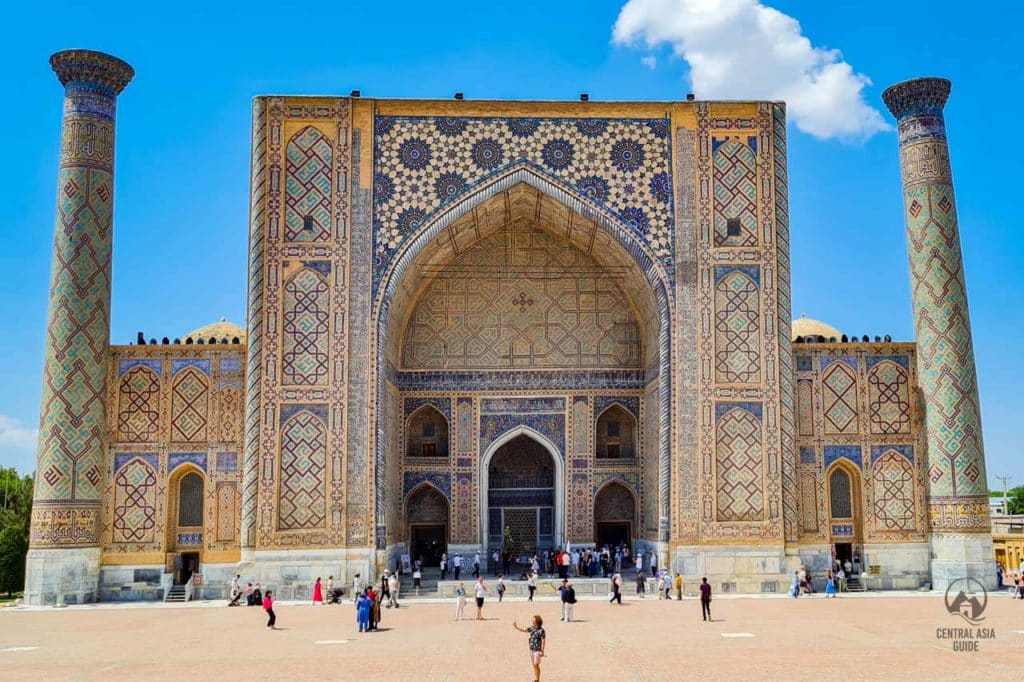

Registan buildings
All the three main buildings of Registan are madrassas, which means an islam university or a college. In Central Asia madrassas usually have a high portal with two high minarets at the edges and an azure dome on top. Inside there are commonly two tiers of hujras (rooms for students) that circle the courtyard which is placed in the middle and the rooms open towards it.
In the far reaches of the courtyard, there are usually smaller buildings under domes – most often a mosque and a library / lecture hall. Today most of the hujras on the first floors of Registan’s madrasas are occupied by souvenir shops and official receptions, concerts or music and light shows are organized for the tourists in the courtyards.

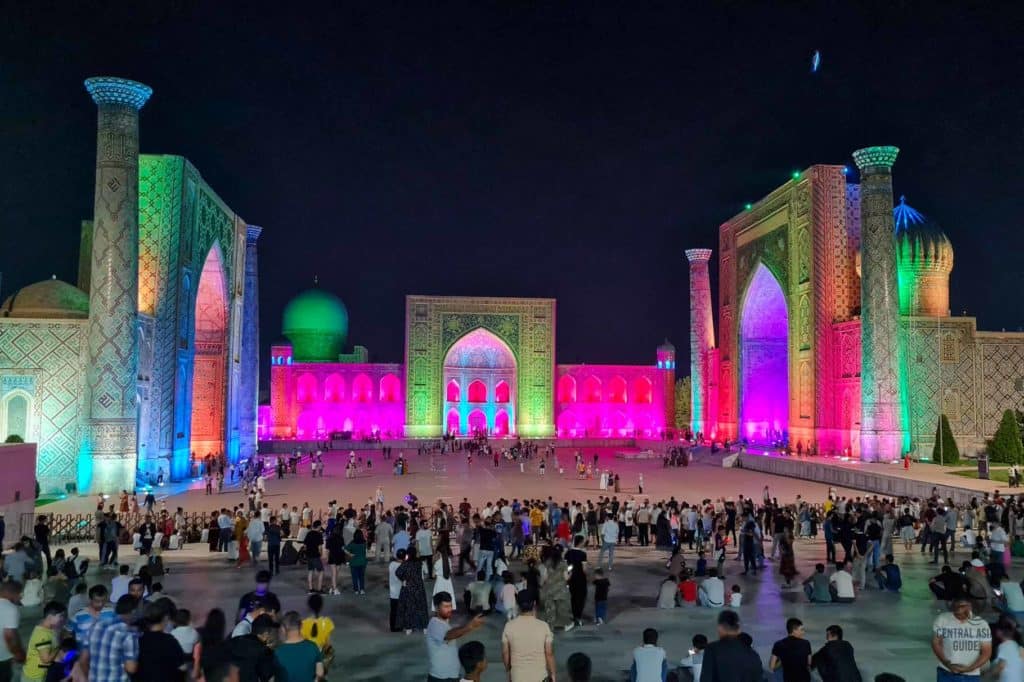
Registan Ulug-Beg Madrasah
From 1417-1420 Timur’s grandson Ulugbeg built a beautiful madrassah on the west side of the square and it is the oldest construction of the registan. While his grandfather is remembered for monumental mosques and mausoleums, Ulugbeg’s legacy is appropriately educational. There Ulugbek himself taught mathematics, among other subjects were theology, astronomy, and philosophy. In addition to this madrassa, Ulugbeg also built madrasas in Bukhara and Gijdovan.
The madrassa occupies an are of 56 m by 81 m and is built around a large, open courtyard. Beneath the little corner domes there were lecture halls and at the rear a large mosque with a beautiful interior and an austere teaching room to one side. The ornate panel above the arch displays a symbolic sky with five and ten pointed stars. Ulugbeg’s madrassah had a platform for astronomical observations before Ulugbeg’s observatory was built in Samarkand and it had fifty cells for one hundred students.
Sheikh Khodja Akhrar and poet Djami were among the outstanding graduates of this madrassah. In the 20th century, the northeastern and southeastern minarets were repaired, new domes were installed and the portal arch and tympan (decoration under the arch) were restored. Ulug Beg was a prominent intellectual who, sadly for his faltering empire, spent more of his time focusing on maths and science than he did on affairs of his state.


Registan Sher-Dor Madrassa
Opposite of Ulug Beg’s madrassa is the Sher-Dor Madrassah built from 1619-1636 and it reminds the style of Ulugbeg’s Madrassah. Ruler of Samarkand, Yalangtush Bakhodur, ordered the construction of the Sher-Dor and Tillya-Kori madrasahs. The Sher-Dor (Having Tigers) Madrasah was designed by the architect Abdujabor. The decoration of the madrasah is not as pure as that on the Ulugh Beg madrasah of the 15th century, which is considered as the “golden age” of Timurid Samarkand architecture.
Yet the harmony of large and small rooms, exquisite mosaic decor, monumentality and efficient symmetry, are all found present here in the building that is definately among the finest architectural monuments of Samarkand. It took 17 years to build but hasn’t held up as well as the Ulugbek Medressa, that was built in just three years. His architects strove to match the first in scale and nobility, though Koranic prohibition against symmetry forbade an exact mirror-image.
Ribbed domes on high towers soared over the two-storied facade on the sides of the front portal and islamic inscriptions, geometrical and floral ornamentation decorate the interior. The tympans of the portal arch are of significant interest in Sher Dor Madrasa. They are decorated with an anthropomorphic depiction of the sun and tiger attacking a fallow deer which suits well the name of the madrasa. This pattern was nearly lost by the middle of the 20th century and has been restored.


Registan Tilya-Kori Madrassa
In between Sher Dor and Ulughbek Medressas is the Tilla-Kari (Gold-Covered) Medressa completed in 1660, with a pleasant, garden-like courtyard inside it.
Tilla-Kari Madrassah appeared on the site where the caravanserai of registan used to be. To include the square in pleasing harmony, Yalangtush had his architects stretch the facades of the third madrassah to 75 meters. It was not only a residential college for students but also played the role of the grand masjid (mosque). Smaller corner turrets are smaller compared to the neighbors, but the mosaics are just as lavish – sprightly solar symbols and interlacing floral motifs in similar colors to the Shir Dor.
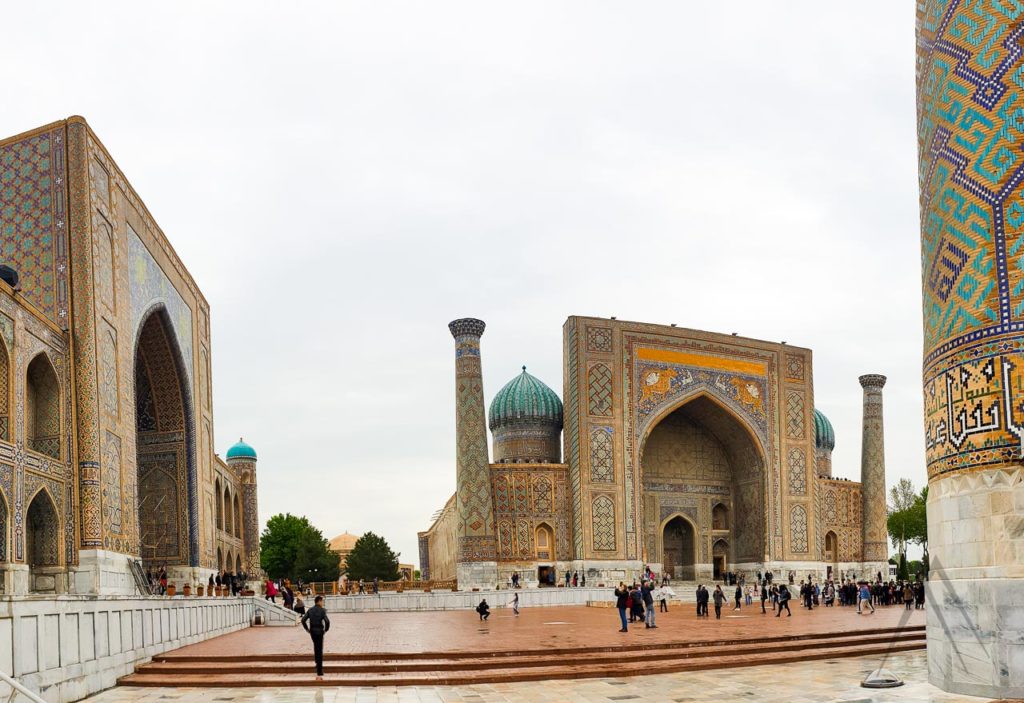
The decor of the Tilya Kori madrasah is rich in gilding according to the name. Other decor techniques were also used: mosaic and majolica with floral and geometric ornaments. The richest gilding on the dome, walls, and mihrab surpassed all other famous buildings in Central Asia. The dome of the mosque remained unfinished until the 20th century and at the same time, its faded facade was restored. A domed mosque was built in the western part of the courtyard. As a result of the earthquake, a part of the Tilla-Kari madrasah, including the main dome, was badly damaged but is now restored.
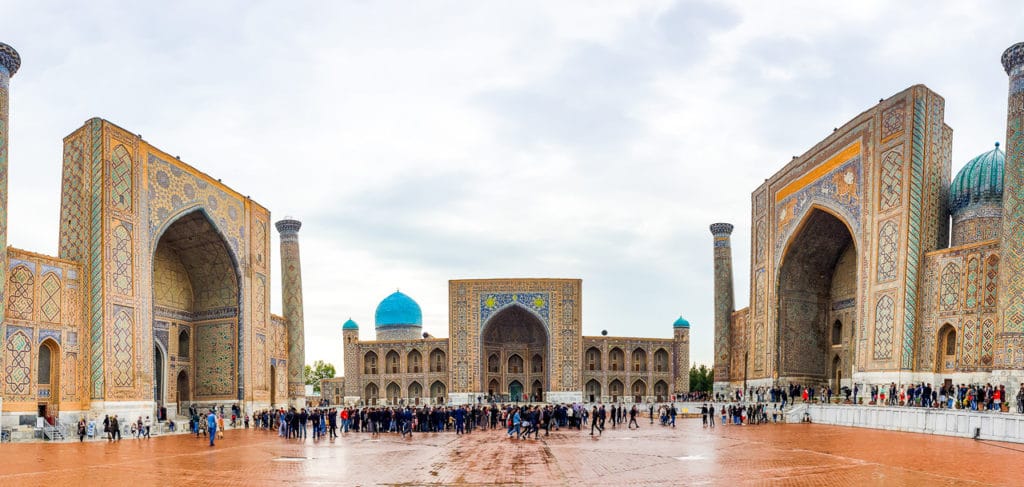
Choursu Art Gallery inside old trading dome
The Chorsu National Art Gallery is not exactly inside the Samarkand Registan but just outside it. For many centuries this building was a place of active trade, as it was located at the intersection of world trade routes connecting Samarkand with Shakhrisabz, Bukhara and Tashkent. It actually reminds a lot the trading domes in Bukhara. This architectural monument has been reconstructed several times and after the major restoration in 2005, an art gallery was opened inside.
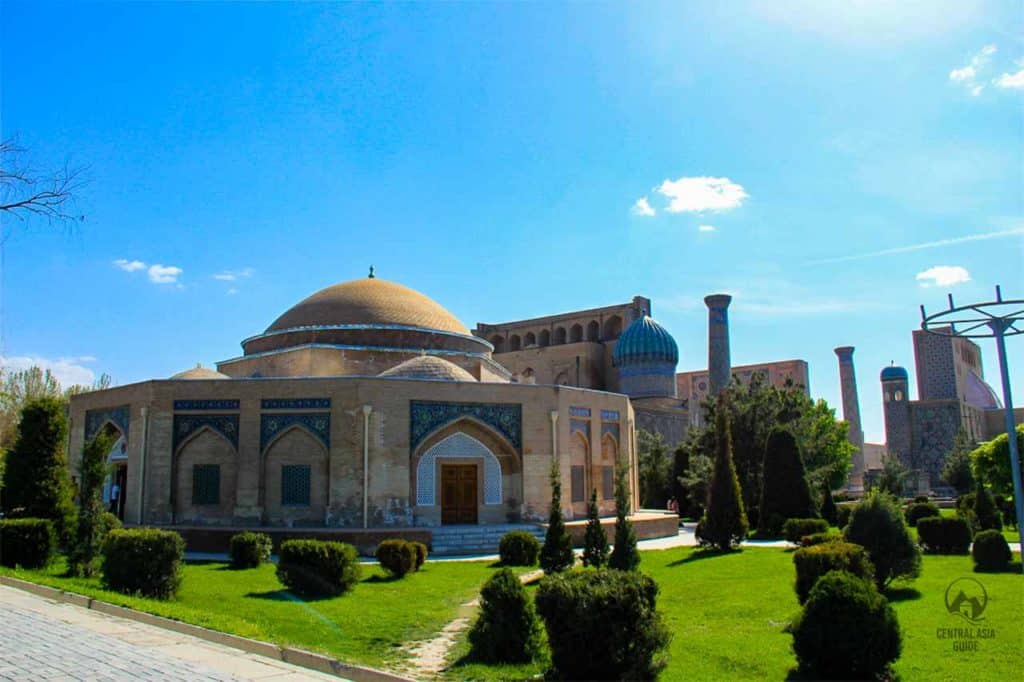
Today, the building of the Art Gallery presents the best works of contemporary Uzbek artists, both well-known and recognized, as well as beginning young talents in addition to the priceless works of the past.
The gallery building has an original hexagonal shape with domes with one large central dome and six small ones above each of the entrances. The building is old as it was built in the 15th century.
Tours including Registan
Other Sights in Samarkand
Page updated 26.3.2022
